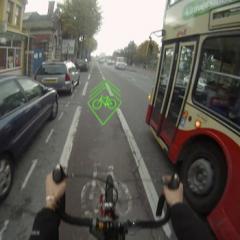 I have been a bit preoccupied with a local bike lane issue for the past few days, so this virtual bicycle lane article from Bike Biz caught my attention this morning. The Blaze concept, by British design student Emily Brooke of the University of Brighton, is a handlebar-mounted laser that projects a personal bike lane (more like a sharrow in the image) on the road ahead of a cyclist. In the article, Emily mentions her reasoning for projecting the laser image so far ahead; “Eighty percent of cycle accidents occur when bicycles travel straight ahead and a vehicle maneuvers into them. The most common contributory factor is ‘failed to look properly’ on the part of the motorist.” With her Blaze concept, motorist would presumably see the image before they see the actual cyclist, preventing that type of accident.
I have been a bit preoccupied with a local bike lane issue for the past few days, so this virtual bicycle lane article from Bike Biz caught my attention this morning. The Blaze concept, by British design student Emily Brooke of the University of Brighton, is a handlebar-mounted laser that projects a personal bike lane (more like a sharrow in the image) on the road ahead of a cyclist. In the article, Emily mentions her reasoning for projecting the laser image so far ahead; “Eighty percent of cycle accidents occur when bicycles travel straight ahead and a vehicle maneuvers into them. The most common contributory factor is ‘failed to look properly’ on the part of the motorist.” With her Blaze concept, motorist would presumably see the image before they see the actual cyclist, preventing that type of accident.
So, what do you think of this idea, which as noted in the Bike Biz article is similar to Alex Tee and Evan Gant’s LightLane concept from 2009 (an entry in the Bicycle Design Commuter Bike design competition). Would a bright projected image on the pavement just cause confusion and add to the many other driver distractions out there on the roadways, or do you think something like this really would make drivers more conscious of a cyclist approaching from behind? As always, I’m curious to hear your thoughts.

Leave a Reply to OTAKUERIC Cancel reply